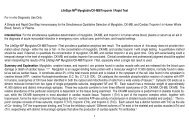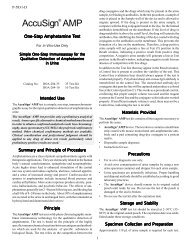MQL - Drug Testing Africa
MQL - Drug Testing Africa
MQL - Drug Testing Africa
Create successful ePaper yourself
Turn your PDF publications into a flip-book with our unique Google optimized e-Paper software.
1. Interference testingThe AccuTest <strong>MQL</strong> test strip performance at cut-off level is notaffected when pH and Specific Gravity ranges of urine specimen areat 4.5 to 9.0 and 1.005 to 1.035.The following substances were tested and confirmed did not interferewith the AccuTest <strong>MQL</strong> test strip at the listed concentrations.Glucose2000 mg/dlHuman albumin 2000 mg/dlHuman hemoglobin 10 mg/dlUrea4000 mg/dlUric acid10 mg/dl2. SpecificityThe following table lists compounds that are detected by theAccuTest <strong>MQL</strong> test strip, which produced positive results whentested at levels equal or greater than the concentrations listed below:Test Compounds Cut-off(ng/ml)<strong>MQL</strong> Methaqualone 300Amitriptyline 50,000Carbamazepine 20,0002’-Hydroxy-methaqualone 3,0003’-Hydroxy-methaqualone 5004’-Hydroxy-methaqualone 500Mecloqualone 500Nortriptyline 50,000Phenytoin 40,000Primidone 24,000Theophylline 40,000The following compounds show no cross-reactivity atconcentration up to 100 g/ml unless specified.AcetaminophenAmitriptylineAtrophineChlopheniramineDigitoxinEcgonine methylesterGuaiacol glycer esterImipramineLidocaineNeomycinPhenylethylamine-Quinine antidineTheophyline4-AcetamidophenolArterenolCaffeineCortisoneDigoxinEphedrineHistamineIbuprofenMeperidineNiacinamidePhenylpropanolamineSalicyclic acidThioridazineAcetylsalicylic acidAspartameCamphorDeoxyephedrineDiphenhydramineEpinephrineHydrochlorothiazideIsoproterenolMethaqualonPerphenazinePromethazineTetracyclineTrifluoperazineAmikacinAscorbic acidChloroquineDextromethorphanEcgonineGentisic acidHomatrophineKetamineMethylphenidatePenicillin GPseudoephedrineTetrahydrozolineTryptophanREFERENCES1. Urine testing for drugs of abuse, NIDA Research Monograph 73 (1986)2. Steven B. Karch, <strong>Drug</strong>s of abuse hand book, CRC Press, 1st. Ed. (1998)3. Ray H. Liu and Bruce A. Goldberger, Handbook of workplace drug testing, AACCPress, Washington DC (1995)4. Stephenson, R.L., Department of Health and Human Services: NLCP ProgramDocument 035, September 1998.5. U.S. Department of Transportation, <strong>Drug</strong> <strong>Testing</strong> Procedures Handbook. p.22,Superintendent of Documents, Government Printing Office, Washington, DC 20402-9325.6. Lafolie, P., Beck, O., Blennow, G., et al., Importance of Creatinine Analyses of UrineWhen Screening for Abused <strong>Drug</strong>s. Clinical Chemistry; 37:1927-31, 1991.7. Goldberger, B.A., Loewenthal, B., Darwin, W.D., and E.J. Cone, IntrasubjectVariation of Creatinine and Specific Gravity Measurements in Consecutive UrineSpecimens of Heroin Users. Clinical Chemistry; 41: 116-117, 1995.8. Needleman, S.B., Porvaznik, M., Ander, D., Creatinine Analysis in Single CollectionUrine Specimens. Journal of Forensic Science; 37: 1125-1133, 1992.9. Mayer, B and Hemphill, G., Evaluation of Urine Creatinine as a Marker to IdentifyDilute Specimens Being Analyzed for <strong>Drug</strong>s of Abuse. Abstract 313. Poster Session,Annual Meeting, American Association of Clinical Chemistry, July 1992.10. Young, D.S., et al., Clinical Chemistry; 21 (9), 1975.11. Friedman, R.B., et al., Clinical Chemistry; 26 (4), 1980.DTA Pty Ltd, Australia1066E Beaufort Street, Unit 6-7, Bedford WA 6052PO Box 109, Inglewood WA 6932email@drugtesting.com.auwww.drugtesting.com.auDTA Pty Ltd, South <strong>Africa</strong>PO Box 1661, Sun Valley 7985 Cape Townemail@drugtesting.co.zawww.drugtesting.co.zaDTP Ltd, New ZealandPO Box 5066, Whangarai 0101email@drugtesting.net.nzwww.drugtesting.net.nzDTA Pty Ltd, EuropePO Box 1614, DK- 2720 Vanløseemail@drugtesting.dkwww.drugtesting.dkAccuTest MANDRAX Test CassetteFOR THE QUALITATIVE ASSESSMENT OFMETHAQUALONE AND THEMETABOLITES IN HUMAN URINEFor in vitro Diagnostic and Forensic UseINTENDED USEThe AccuTest <strong>MQL</strong> test strip is an immunochromatography basedone step in vitro test. It is designed for qualitative determination ofdrug substances in human urine specimens. This assay may be usedin the point of care setting. The cut-off concentration using our test isas follows;Methaqualone (<strong>MQL</strong>) 300 ng/mlThis assay provides only a preliminary analytical test result. A morespecific alternative chemical method must be used in order to obtain aconfirmed analytical result. The Substance Abuse Mental HealthServices Administration (SAMHSA) has established gaschromatography/ mass spectrometry (GC/MS) as the preferredconfirmatory method. Clinical consideration and professional judgmentshould be applied to any drug of abuse test result, particularly whenpreliminary positive results are indicated.Note: It is not for use in diagnosing disease or illness; it is forinvestigational use only.SUMMARY AND EXPLANATIONMandrax is a synthetic drug that is compiled by means of the mixing ofchemicals in a chemical process and a tablet is then produced. Theactive ingredient in Mandrax is Methaqualone.In the sixties and early seventies these tablets were prescribed assleeping tablets. Other medicinal uses included illnesses like highblood pressure and anxiety attacks.Mandrax was originally known as a safe and non-dependent drug. Itwas the drug that people reckoned was going to be the miracle curesof the world at its time.It was however found that Mandrax had various side effects,especially if it was used with marijuana and alcohol, which was lifethreatening because it caused psychological and physicaldependency. This caused a drastic increase in burglaries, especiallyat pharmacies, where it was found that Mandrax specifically wasstolen. Mandrax was banned in most parts of the world because of themisuse.The banning of Mandrax caused crime syndicates to use thisopportunity to continue producing it by means of clandestinelaboratories. The market was already established and the need for thedrug made it a profitable business.page 5 page 6page 1
<strong>MQL</strong>PRINCIPLEThe test strip is based on the principle of specific immunochemicalreaction between antibodies and antigen to analyze particularcompound in human urine specimen. The assay relies on thecompetition for binding antibody. When drug is present in the urinespecimen, it competes with drug conjugate for the limited amount ofantibody dye conjugate. When the amount of drug is equal or morethan the cut-off, it will prevent the binding of drug conjugate to theantibody. Therefore, a positive urine specimen will not show a coloredband on the test line zone, indicating a positive result, while thepresence of a colored band indicates a negative result. A control lineis present in the test window to work as procedural control. Thiscolored band should always appear on the control line zone if the testdevice is stored in good condition and the test is performedappropriately.MATERIAL PROVIDED1. An AccuTest <strong>MQL</strong> test cassette.The amount of each coated antigen and/or antibody on the strip isless than 1.0 mg for antigen conjugate and is less than 1.0 mg forgoat anti- mouse IgG antibody.Test zone: contains drug bovine protein antigen conjugatesControl zone: contains Goat anti-mouse IgG antibodyConjugate pad: contains mice monoclonal anti-drug antibody.2. Dropper3. Instruction for use.MATERIAL REQUIRED BUT NOT PROVIDED1. Urine collection container.2. Timer or clock.WARNINGS AND PRECAUTIONS1. For in vitro diagnostic and professional use only.2. Do not use the test strip beyond the expiration date.3. Urine specimens may be infectious; properly handle and dispose ofall used reaction devices in a biohazard container.4. Visually inspect the foil package to insure it is intact. If the packageis not intact, the integrity of the device might be compromised.5. Use a new urine specimen cup for each sample to avoid crosscontamination.STORAGE AND STABILITYThe test device should be stored at 2°C to 28°C; do not freeze andwill be effective until the expiration date stated on the package. Theproduct is humidity-sensitive and should be used immediately afterbeing open. Any improperly sealed product should be discarded.SPECIMEN COLLECTION AND PREPARATIONFresh urine does not require any special handling or pretreatment.Specimen should be collected in a clean, dry, plastic or glasscontainer. If the assay is not performed immediately, urine specimenmay be refrigerated at 2- 8 °C or frozen up to 7 days. Specimensshould be brought to room temperature before testing. Urinespecimens exhibiting a large amount of precipitate or turbidity shouldbe centrifuged or allowed to settle before testing. Avoid contact withskin by wearing gloves and proper laboratory attire.QUALITY CONTROLGood Laboratory practice recommends the daily use of controlmaterials to validate the reliability of device. Control materials shouldbe assayed as clinical specimen and challenging to the assay cutoffconcentration, e.g., 25% above and below cutoff concentration. Ifcontrol values do not fall within establish range, assay results areinvalid. Control materials that are not provided with this test kit arecommercially available.page 2The AccuTest <strong>MQL</strong> test kit provides a built-inprocess control with a different antigen/antibodyreaction at the control region (C). This control lineshould always appear regardless the presence of drugor metabolite. If the control line does not appear, thetest device should be discarded and the obtained resultis invalid. The presence of this control band in thecontrol region serve as 1) verification that sufficientvolume is added, 2) that proper flow is obtained.PROCEDURE1. Bring all materials and specimens to roomtemperature.2. Remove the test strip from sealed foil pouch.3. Place the sample pad end of the test strip (up to thebottom blue line mark) into the urine specimen.4. Hold the strip in the urine for 10 seconds, removefrom the urine.5. At 5 minutes, read the test strip.Do not interpret the result after 5 minutes. Waitingmore than five minutes may cause the reading tobe inaccurate. To avoid confusion, discard the teststrip after interpreting the result.INTERPRETATION OF RESULTSNegative:Two colored bands form on any strip of thecard. The appearance of two colored bands,one in test line zone and the other in controlline zone, indicates negative result for thatparticular test(s). The negative result doesnot indicate the absence of drug in thespecimen; it only indicates the level oftested drug in the specimen is less than cutofflevel.Positive:One colored band appears in control linezone. No coloured band is found in test linezone. This is an indication the level of testeddrug(s) in the specimen is above the cut- offlevel.Invalid:If there is no colored band in control linezone of any strip, the test result is invalid.Retest the sample with a new device.Note: A borderline(+/-) in test line zone should beconsidered negative result.page 3LIMITATION OF PROCEDUREThe assay is designed for use with human urine only. A positive resultwith any of the tests indicates only the presence of a drug/metaboliteand does not indicate or measure intoxication. There is a possibilitythat technical or processed urine error as well other substances incertain foods and medicines may interfere with the test and causefalse results. Please refer “SPECIFICITY” section for lists ofsubstances that will produce either positive results, or that do notinterfere with test performance. If a drug/metabolite is found present inthe urine specimen, the assay does not indicate frequency of drug useor distinguish between drug of abuse and certain foods andmedicines.EXPECTED RESULTSThe AccuTest <strong>MQL</strong> test strip is a qualitative assay. It identifies thedrug in human urine at its cut-off concentration or higher. Theconcentration of the drug cannot be determined by this assay. Thetest is intended to distinguish negative result from presumptivepositive result. All positive results must be confirmed using analternate method, preferably GC/MS.PERFORMANCE CHARACTERISTICSA. AccuracyThe accuracy of the AccuTest <strong>MQL</strong> test strip was compared andchecked against commercially available tests with a threshold value atthe same cut-off levels. Urine samples taken from volunteers claimingto be non-users were examined under both tests. The results were>99.9% in agreement.B. SensitivityThe cut-off concentrations (sensitivity level) of AccuTest <strong>MQL</strong> teststrip is determined to be:<strong>MQL</strong>300 ng/ml.C. PrecisionThe precision of the AccuTest <strong>MQL</strong> test strip was determined byconducting the test with spiked controls and interpreted the results bythree individuals to verify the random error of visual interpretation. Theresults of 50% above and 50% below cut-off specimens are 100%agreed by three observers:Tested<strong>Drug</strong>Concentration(ng/ml)NumberTestedCorrectedResult%CorrectedResult<strong>MQL</strong> 300 40 40 100D. SpecificityThe specificity for adding various drugs, drug metabolites testedthe AccuTest <strong>MQL</strong> test strip, and other compounds that arelikely to be present in urine. All compounds were prepared in drug-free normal human urine.page 4<strong>MQL</strong><strong>MQL</strong> (-) <strong>MQL</strong> (+)












